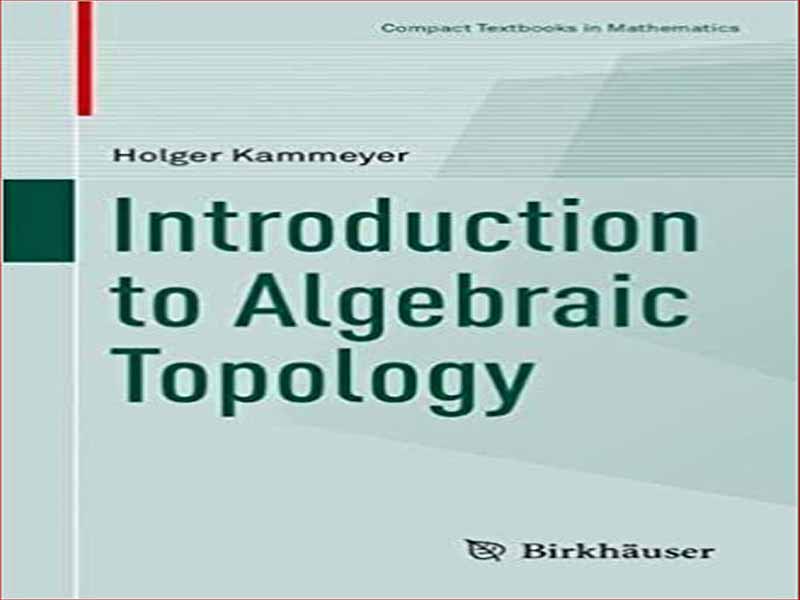- عنوان کتاب: Introduction to Algebraic Topology
- نویسنده: Holger-Kammeyer
- سال انتشار: 2022
- حوزه: جبر
- تعداد صفحه: 185
- زبان اصلی: انگلیسی
- نوع فایل: pdf
- حجم فایل: 4.42 مگابایت
این کتاب خواننده را با دو مفهوم اساسی توپولوژی جبری آشنا می کند: گروه بنیادی و همسانی. ما دیدگاهی مدرن خواهیم داشت تا دوره را با مطالعه مفاهیم پایه از نظریه مقوله آغاز کنیم. گروه بنیادی پس از آن به عنوان یک مورد خاص از گروه بنیادی در نظر گرفته می شود. بر این اساس، ابتدا قضیه ون کامپن را در یک نسخه طبقه بندی شده به دلیل R. Brown اثبات می کنیم و سپس نحوه محاسبه واقعی گروه بنیادی یک فضای پیوست را توضیح می دهیم. ما به ارائه همسانی می پردازیم. برای انتقال این ایده، همسانی ساده را می سازیم و بدیهیات آیلنبرگ-استینرود را در یک نظریه همسانی ایجاد می کنیم. بعد، همسانی مفرد را می سازیم و نشان می دهیم که بدیهیات را برآورده می کند. پس از آن، ما ماشینآلاتی را برای محاسبات تئوریهای همسانی توسعه میدهیم، محاسبات مثالی ارائه میکنیم، و برخی کاربردها مانند قضیه نقطه ثابت Brouwer و قضیه Borsuk-Ulam را میبینیم. در نهایت، همسانی سلولی را برای کمپلکسهای CW معرفی میکنیم. به عنوان نتیجه نهایی، ما نشان میدهیم که بدیهیات Eilenberg Steenrod همسانی معمولی را در مجتمعهای CW تعیین میکند. فرض می کنیم خواننده یک دوره مقدماتی در زمینه توپولوژی گذرانده است و با مفاهیم توپولوژی مجموعه نقطه، تعریف گروه بنیادی و نظریه پوشش آشنا است. چنین دوره ای مطمئناً توپولوژی ضریب را پوشش می دهد، اما از آنجایی که این مفهوم برای اهداف ما از اهمیت اساسی برخوردار است، ما تصمیم گرفتیم که خلاصه ای را در ضمیمه A قرار دهیم. جبر ابتدایی نیز به همین ترتیب در سراسر متن اعمال خواهد شد. به طور خاص، ما با ماژول ها روی حلقه های جابجایی و در موارد نادر نیز با محصولات تانسور آنها کار خواهیم کرد. هر فصل با چند تمرین به پایان می رسد. برخی از آنها نه تنها به منظور ارائه یک زمینه آزمایشی برای کار با مفاهیم جدید هستند، بلکه حقایق و اصطلاحات اضافی را نیز ایجاد می کنند که دانستن آنها در زمینه داده شده مفید است. تعداد بیشماری کتاب عالی در زمینه توپولوژی جبری در بازار موجود است. به عنوان مثال، برخی از متون، [29]، یک ارائه رسمی را انتخاب می کنند و برای ادامه برنامه درسی فرد با یک دوره نظریه هموتوپی مناسب هستند. دیگران، مانند [8] بیشتر هندسی فکر می کنند و ممکن است انتخاب بهتری برای تخصص بعدی در توپولوژی کم بعدی باشند. آنچه این متن سعی در انجام آن دارد این است که نه از مفاهیم انتزاعی دوری کند و نه از ارائه شهود هندسی یا انجام محاسبات آسان، و در عین حال عدالت را در این مجموعه رعایت کند و یک کتاب درسی فشرده باشد: ما فقط به همان اندازه مطالبی را ارائه می دهیم که منطقی می دانیم. برای پوشش در یک دوره تحصیلات تکمیلی ترم اول در زمینه توپولوژی جبری. شش فصل هر کدام به پنج بخش تقسیم می شوند، به طوری که در یک ترم معمولی 15 هفته ای با دو جلسه در هفته، باید به طور متوسط یک بخش را در هر سخنرانی پوشش داد. با این حال، این یک تخمین تقریبی است زیرا برخی از بخشها از سایر بخشها قابل توجهتر هستند، بنابراین ارائه تخته سیاه به میانبرهایی نیاز دارد. با این حال، ما از مدرس می خواهیم که سعی نکند و از بخش فنی ظاهر شود. 2.3 در کوفیبراسیون ها و فشارهای هموتوپی. این به طور مخفیانه به همان اندازه که ما برای ارائه صحیح نتایج در فصل های بعدی لازم بدانیم، نظریه هموتوپی را ارائه می دهد.
This book introduces the reader to the two most fundamental concepts of algebraic topology: the fundamental group and homology. We shall take a modern viewpoint so that we begin the course by studying basic notions from category theory. The fundamental group is afterwards treated as a special case of the fundamental groupoid. Accordingly, we first prove van Kampen’s theorem in a categorical version due to R. Brown and then explain how to actually compute the fundamental group of an attaching space. We move on to present homology. To convey the idea, we construct simplicial homology and motivate the Eilenberg–Steenrod axioms of a homology theory. Next, we construct singular homology and show that it satisfies the axioms. Afterwards, we develop machinery for computing homology theories, give example calculations, and see some applications such as the Brouwer fixed point theorem and the Borsuk–Ulam theorem. Finally, we introduce cellular homology for CW complexes. As the concluding result, we show that the Eilenberg Steenrod axioms determine ordinary homology on CW complexes. We assume the reader has taken an introductory course on topology and is familiar with point set topological concepts, the definition of the fundamental group, and covering theory. Such a course will certainly have covered the quotient topology, but since this concept is of fundamental importance for our purposes, we have decided to include a recap in Appendix A. Elementary algebra will likewise be applied throughout the text. In particular, we will work with modules over commutative rings and on rare occasions also with their tensor products. Each chapter ends with a couple of exercises. Some of them are not only meant to provide a test ground for working with the new concepts but they also establish additional facts and terminology which are helpful to know in the given context. A myriad of excellent books on algebraic topology are available in the market. Some texts, for example, [29], choose a formal presentation and are well suited to continue one’s curriculum with a course on homotopy theory. Others, like [8] are more geometrically minded and might be a better choice for subsequent specialization in low-dimensional topology. What this text tries to accomplish is to neither shy away from abstract concepts nor from providing geometric intuition or doing easy calculations, and at the same time do justice to the series and be a compact textbook: We present only as much material as we found reasonable to cover in a first semester graduate course on algebraic topology. The six chapters are divided into five sections each, so that in a typical 15-week semester with two meetings a week, one should cover one section per lecture on average. This is however a rough estimate as some sections are more substantial than others so that the blackboard presentation will need some shortcuts. However, we urge the lecturer not to try and skip the technical appearing Sect. 2.3 on cofibrations and homotopy pushouts. It secretly provides as much homotopy theory as we deem necessary for the correct presentation of the results in the ensuing chapters.
این کتاب را میتوانید از لینک زیر بصورت رایگان دانلود کنید:
Download: Introduction to Algebraic Topology



































نظرات کاربران